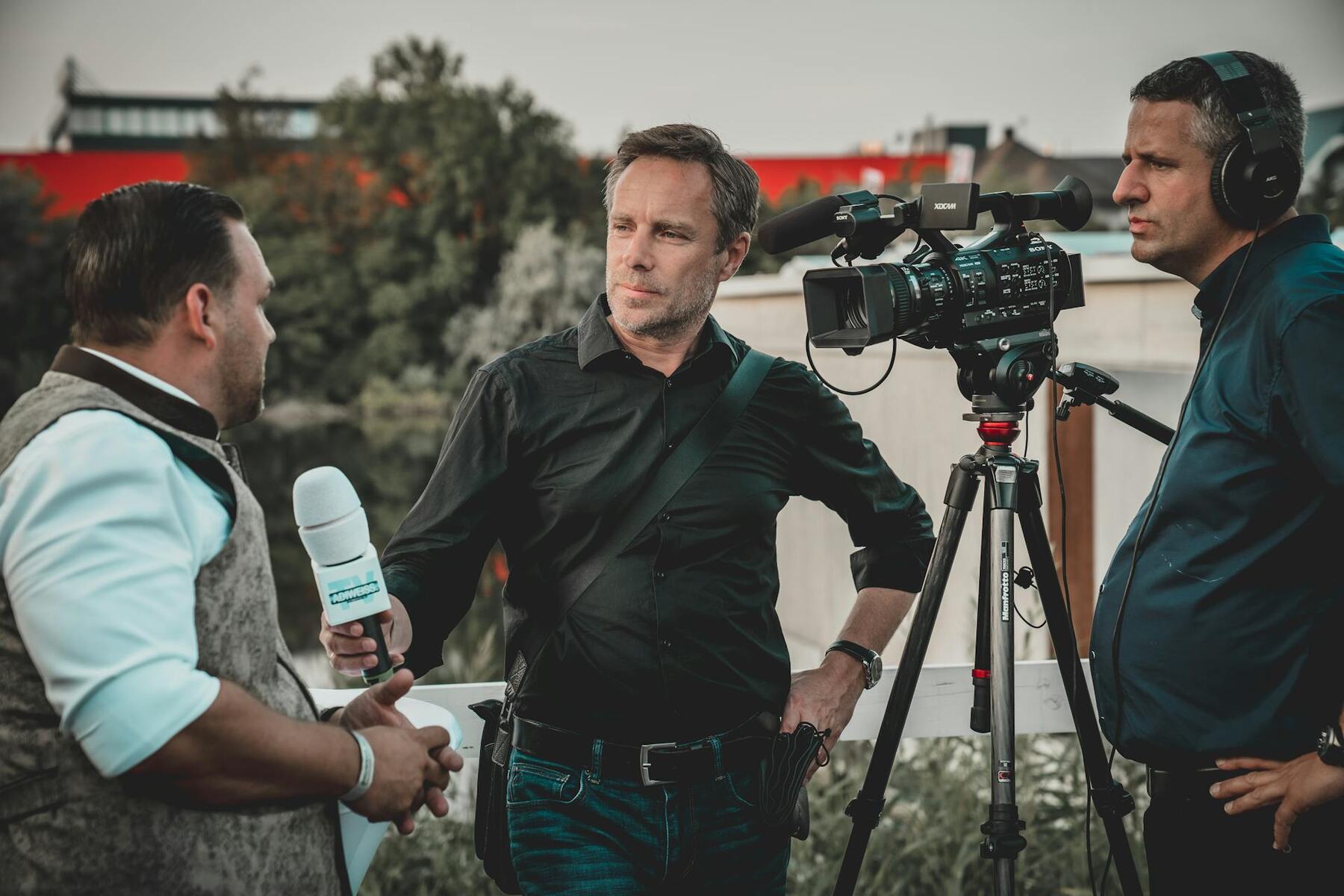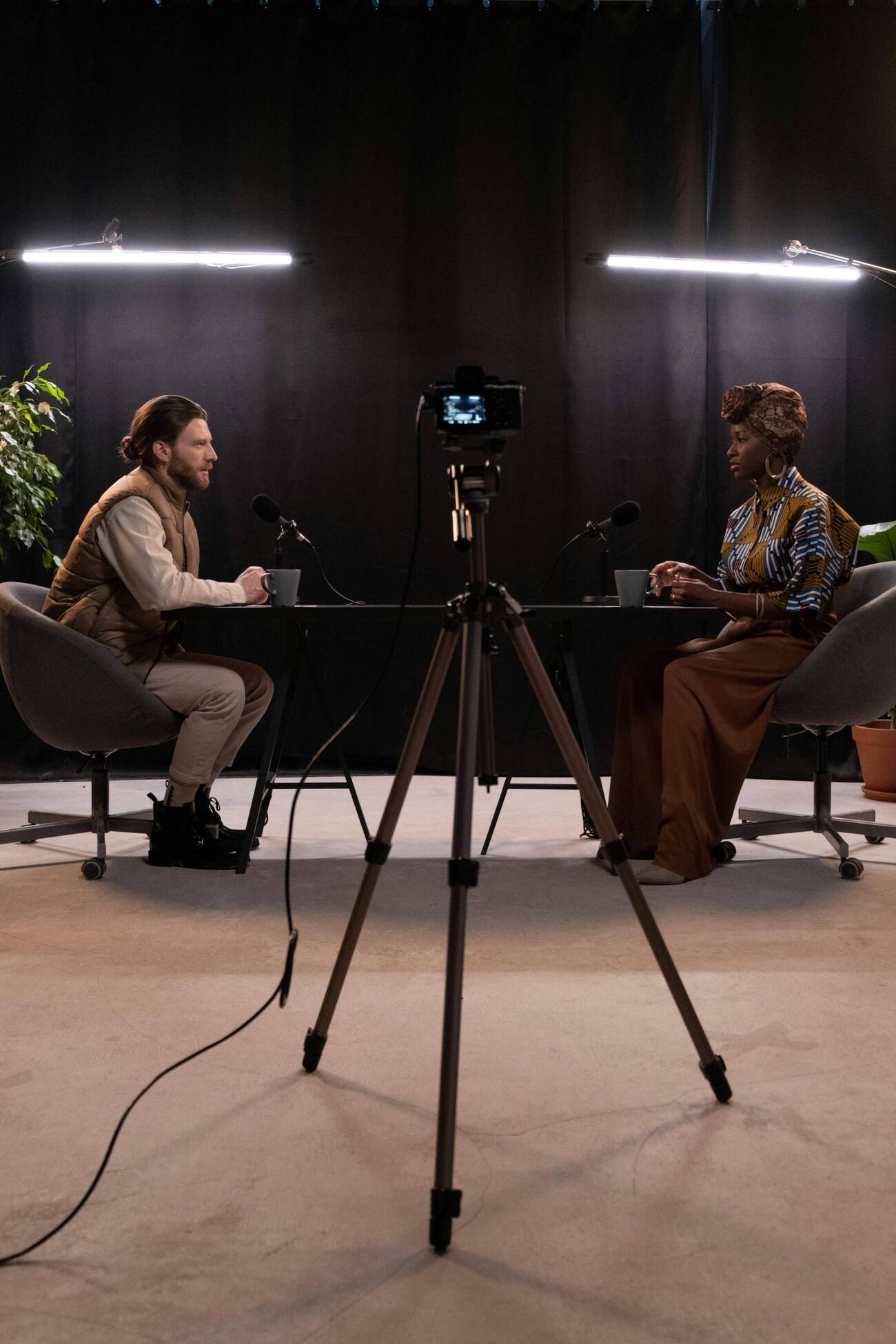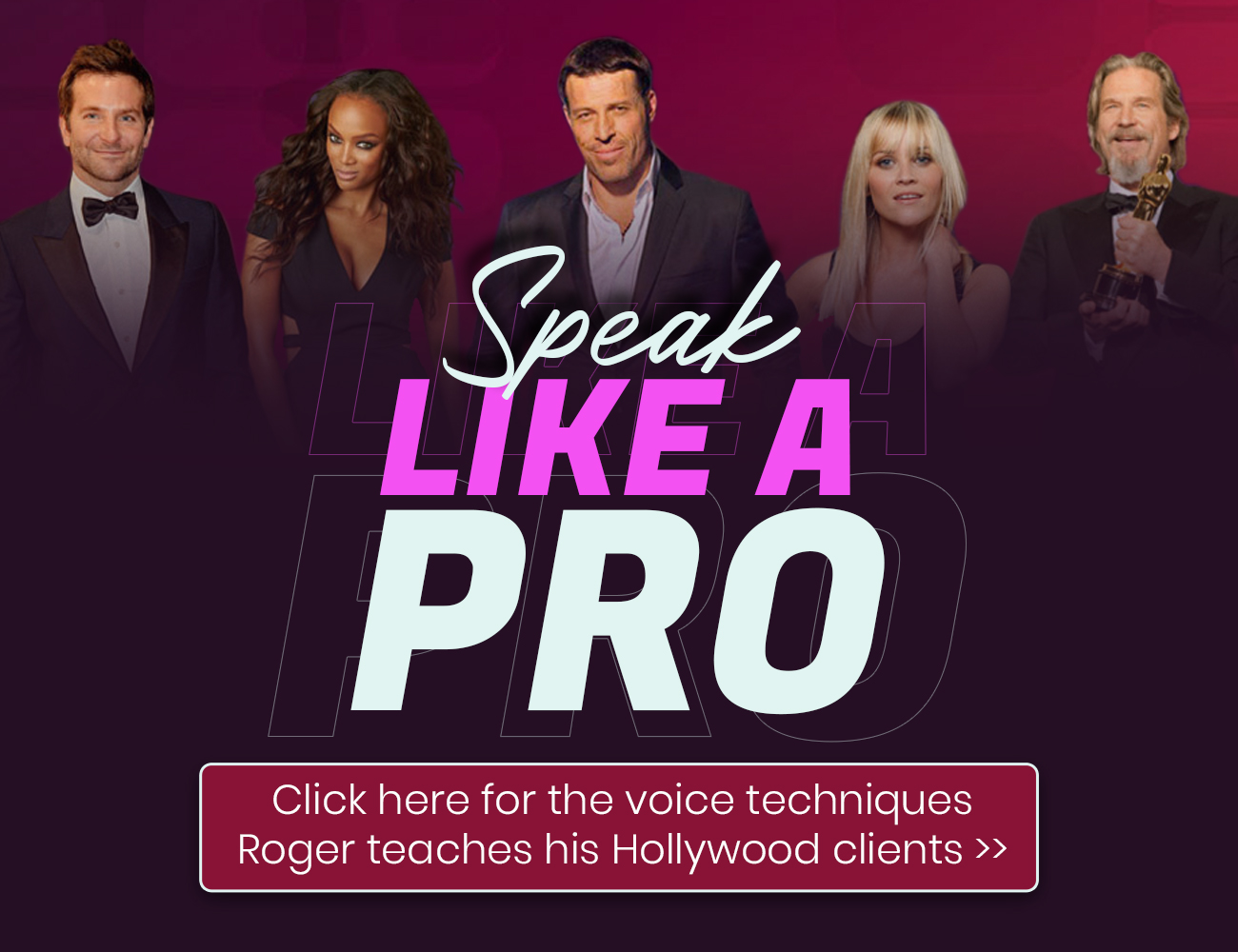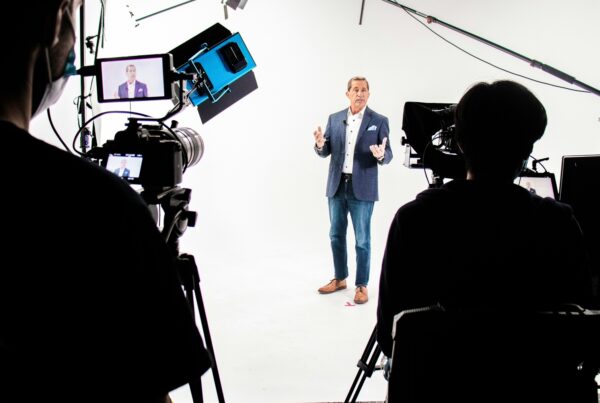Are you conscious about appearing stiff, uncomfortable, and unconvincing when speaking on camera? As seasoned vocal coaches, we’ve seen this happen to people way too many times. To ensure you appear comfortable and confident, we put together this guide packed with tips for speaking on camera.
Tips for Speaking on Camera
To excel at speaking on camera, you must first prepare your equipment, lighting, and outfit appropriately. Then, create an engaging script and incorporate storytelling techniques to captivate your audience. You can then master your delivery through the right tone and pace, engaging body language, direct eye contact with the camera, and conversational language. 
Consistently practicing, utilizing deep breathing exercises to overcome anxiety, and noting scope for improvement from recorded sessions will further refine your on-camera skills. By applying these tips, you’ll be well on your way to deliver more polished and engaging presentations.
| Tip | Actions to Take |
| Prepare equipment and attire | Use proper equipment setup, optimal lighting conditions, and finalize an appropriate attire for a professional and polished appearance. |
| Craft content | Write a compelling script, thoroughly understand your topic, and incorporate storytelling techniques to captivate your audience. |
| Master delivery | Modulate your tone and pace, use engaging body language, look directly at the camera, and employ conversational language to connect with viewers. |
| Keep practicing | Utilize deep breathing exercises to overcome anxiety, record practice sessions, and seek feedback to refine your on-camera skills. |
Set Up for Success
Choosing the right tools, setting the stage with optimal lighting and sound, and selecting attire that complements your on-screen presence are critical components for successful on-camera speaking.
Choosing the Right Equipment
One of the first steps you need to take when practicing speaking in front of the camera is to invest in the proper equipment.
- Camera: Invest in a high-quality camera that delivers clear video. A DSLR or mirrorless camera often provides superior quality over a standard webcam.
- Microphone: Audio clarity affects your message delivery, so picking a professional grade mic can significantly enhance our vocal presence.
- Ring light: A ring light creates even, soft lighting on our face, reducing shadows and highlighting features.
- Teleprompter: A teleprompter can help you sound natural as it allows you to look directly at the camera lens while delivering your lines.
Optimizing Sound, Lighting, and Connectivity
Poor lighting, distracting sounds, and faulty equipment are physical barriers that can negatively affect your focus. Part of our training teaches students how to overcome these technological glitches that can disrupt your flow as you speak in front of a camera.
- Lighting arrangement: Position lights in front of you and slightly above eye level to cast a natural look and avoid harsh shadows.
- Soundproofing: Simple soundproofing tactics can suppress echo, such as using carpeting or acoustic panels in our recording space.
- Connectivity: Invest in a stable and high-speed internet connection. It also helps to test the teleprompter software and hardware setup before recording or doing a live session.
Dressing for the Camera
Research shows that dressing up aligns with your desired self-perception. For example, wearing formal clothes may make you feel more in control and ready. This positively influences your cognitive abilities and confidence in speaking in front of cameras.
Craft Your Content
Before stepping in front of the camera, it’s crucial to divert your focus to creating engaging material that keeps your audience engaged. As we teach you how to gain a deep understanding of your chosen topic and write a well-structured script, you can weave storytelling into your presentation to connect with your viewers.
Understanding Your Topic
To convey your message with confidence, you should first thoroughly understand the topic.
- Dive deep into the subject matter to become conversant in different aspects.
- Anticipate questions the audience may have and insert the answers into your content.
- Relate complex ideas using metaphors the audience can easily grasp.
Writing a Compelling Script
A well-thought-out script is the backbone of your on-camera presentation. During our training classes, we help students develop their scripts using these simple steps:
- Start with an outline that includes your main points.
- Add bullet points to serve as effective prompts and keep your delivery natural.
- Develop a clear structure with an introduction, body, and conclusion.
- Use simple language and short sentences for clarity and impact.
- Emphasize key phrases to highlight important concepts.
Incorporating Storytelling
One of the things our students used to struggle with was how to infuse storytelling in their scripts. After completing our masterclasses, they found the secret to good storytelling and how it transforms presentations from mundane to memorable.
- Share personal anecdotes or case studies to illustrate points.
- Use a blend of emotional and factual narrative to engage viewers on different levels.
- Present challenges and solutions through storytelling to create a relatable journey.
Master Delivery and Engage With the Audience
Your tone, pace, and body language convey your confidence and help you connect with your audience while speaking in front of a camera. Aside from perfecting framing and body positioning in on-screen presentations, the goal is to make a genuine connection with viewers.
Perfecting Tone and Pace
Among the things we teach in each individual and the complete manual for navigating corporate communication is how to use vocal variety to keep the audience engaged. This involves:
- Being steady and assertive to show confidence.
- Enunciating each word for clarity to avoid misunderstanding.
- Moderating the pace of speech (not too fast to overwhelm, nor too slow to bore).
- Practicing reading aloud to help you be more aware of your natural speaking rhythm.
- Learning how to speak along with a beat to develop a consistent rhythm.
Enforcing Body Language Effectively
The 7-38-55 rule suggests that 7% of communication is done verbally. The rest consists of non-verbal components, with 38% coming from your voice tonality and 55% depends on your body language.
Body language is a powerful aspect of communication. Use it to reinforce your message.
- Project a confident posture by standing or sitting up straight and avoiding slouching.
- Keep natural facial expressions to match the tone of what we’re saying.
- Use hand gestures to illustrate points.
- Maintain an open and approachable posture to foster trust with your viewers.
Looking Directly at the Camera
Looking directly at the camera lens is akin to making eye contact in in-person conversations. This practice helps foster a personal connection with the audience, making them feel acknowledged. Here are some tactics that helped our students achieve confidence in speaking directly in front of a camera:
- Imagine speaking to a friend rather than a lens to help maintain natural eye contact.
- Avoid the urge to look at yourself if using a screen with a video feed, as this can break the connection with the viewer.
- Allow your personality to shine through; a genuine smile can make the interaction feel more personal.
Using Conversational Language
Practice using conversational language to connect with your audience. This lets the audience feel that they are in a dialogue, not just passively receiving information.
- Speak clearly and at a natural pace to encourage engagement.
- Embrace your authentic self and be yourself; it makes the message more relatable.
Practice Confidence-Building
To master speaking on camera, you need to focus on consistent practice and reviewing your performance. This iterative process helps you overcome anxiety, improve your speaking abilities, gain ideas for starting a public address and maintain a steady pace.
Overcoming Anxiety
About 77% of people feel anxious about public speaking. As you experience anxiety, you may also feel other negative emotions like fear and frustration. These can affect your choice of words, distracting you from delivering your message properly, which may then lead to miscommunication.
To ease this fear, follow these simple exercises we use in our training sessions:
- Deep breathing: Start by taking deep breaths to calm your nerves before recording.
- Facing the fear: Acknowledge the anxiety rather than avoiding it. This acceptance can reduce its power over you.
- Keep yourself hydrated: Keeping yourself hydrated by drinking plenty of water can help prevent dry mouth or voice fatigue. This enables you to speak clearly and maintain a consistent tone throughout your on-camera performance.
Recording Practice Sessions
Since we record practice sessions, we can immediately provide feedback about your performance. It lets you identify areas that need improvement, such as body language, tone, or pacing.
You can also track your progress here and see how much you’ve improved over time. Seeking feedback from others on your practice recordings can provide valuable insights and help you refine your techniques for a more polished and engaging on-camera presence. 
Related Questions
How to Speak Properly on Camera?
To speak properly on camera, keep your speech clear and appropriately paced. Project your voice confidently and use inflections to keep your audience engaged, much like you would in a real conversation. Remember, the goal is to connect with your viewers, not just present information.
How Do You Look At the Camera When Speaking?
When looking at the camera, treat the lens as if it’s the eyes of your audience. Look directly at the lens to create a personal and direct connection with your viewers.
How to Act Naturally in Front of a Camera?
Acting naturally on camera comes from practice and relaxation. Keep your body language open and use gestures just as you would in a normal face-to-face dialogue. Remaining conversational and embracing your unique style can make viewers feel more comfortable and connected.
Conclusion
Practicing is key to speaking on camera. Start with a script you believe in and know inside out, this can help you speak conversationally and confidently. From the lighting and sound setup to your attire, body language, tone, and pace – pay attention to every little detail. Aside from attending our masterclasses, these tips can help you eventually see improvement in your delivery.














